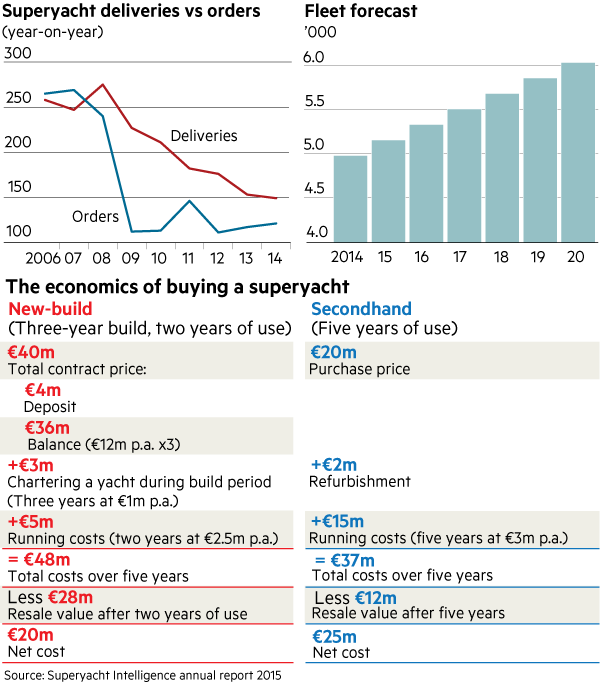How to purchase a yacht: try before you buy

Roula Khalaf, Editor of the FT, selects her favourite stories in this weekly newsletter.
You’ve built your business empire and it’s time to enjoy the rewards. There’s the country pile, the smart cars and a watch for every day of the week. A friend has invited you on to his yacht, and now you want one — preferably something bigger and better.
But you know nothing about how to buy a yacht. Can you knock on the door of a shipyard? A Lürssen or a Feadship wouldn’t turn you away, but they might ever so gently ask you to join the queue.
Buying a custom-built superyacht is one of the most complex purchases one can make. They don’t come off the shelf, though you can buy one second-hand. Monaco Yacht Show is the place to come for second-hand — and new ones, but that could take five years to build. Can you wait that long?
What features do you want? Is a helipad, for example, essential?
If it’s size you’re after, something in excess of 50 metres, say, you will need help, someone you can trust, who doesn’t have something to sell. In fact, you’re going to need a team.
So where do you start? It depends who you ask. A broker will say: “Start with me” — and that might not be a bad idea. Experienced brokers know the market, but how many of them are truly independent? Sometimes, they’re taking commission from the yard on build cost; surely a conflict of interest?
Alternatively, you could start at a design office. But brokers, designers and industry specialists almost all agree on one thing: try before you buy.
Matthew Chatt-Collins, director at Andrew Winch Designs, says: “Charter a few yachts to compare them. You might try four or five, then commission a company. Or you could do another year of charter, and while you’re thinking over designs, buy a second-hand one.”
But even buying a second-hand yacht is perilous as there are so many duds on the market. “A buyer may look at one that’s just five years old,” says Chris Cecil-Wright, a broker, “but if it hasn’t been looked after, there will be problems. I’d advise not to order a new boat; best to charter first. The next step should be a good second-hand boat.”
So how can you find one in a market dominated by brokers? One answer is to use another broker, independent of the seller, or lean on a trusted captain.
If using a broker, how can you be assured of their independence? Barry Gilmour, chair of Royale Oceanic, says: “It’s a good idea to ask around for an intermediary. You need to know your broker. Some have relationships with certain builders and will drive business that way.”

If a family office represents your interests, it may have to seek out a knowledgeable intermediary. In fact, before you have finished, you will have dealt with a whole slew of agencies — lawyers, registration agents, naval architects and technical consultants.
The yacht never sleeps, generating mooring, maintenance and staff costs every day. These vary, but a rule of thumb is 10 per cent of the sale price each year.
Mark Cavendish, marketing director of Heesen yachts, lists four golden rules: if the deal looks too good to be true, it is; for new builds, you should ask about the reliability of the yard; you should also look at its reputation on after-sales service; and think about second-hand values.
“If second-hand value matters, you should buy a boat that will appeal to a wider ownership rather than individual tastes,” Mr Gilmour advises. “More dreams have been broken in building luxury yachts than any other industry.”
Comments